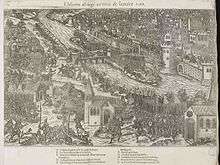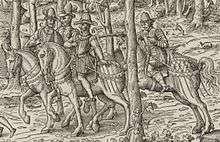Siege of Orleans (1563)
The siege of Orleans was part of the First French War of Religion, a conflict provoked by the Massacre of Vassy by Catholic troops of the Duke of Guise on 1 March 1562. As a result, the Prince of Conde, military leader of the Reformers, moved into Orleans to turn it into one of his strongholds. The city became Protestant; only reformed worship was tolerated; its institutions (the governor, the city aldermen, etc.) became dominated by Protestants, the bishop was removed in April 1562 and churches were desecrated and relics destroyed.
| Siege of Orleans | |||||||
|---|---|---|---|---|---|---|---|
| Part of Wars of Religion | |||||||
 The siege of Orleans, 1570 engraving by Tortorel and Perrissin. | |||||||
| |||||||
| Belligerents | |||||||
| Huguenots | Catholic | ||||||
| Commanders and leaders | |||||||
| François de Coligny d'Andelot | Francis of Guise † | ||||||
In 1563, Catholic troops led by the Duke of Guise set out to recapture Orleans, the defence of which was entrusted to the brother of Admiral de Coligny, François de Coligny d'Andelot. On 18 February 1563, when the position of the besieged had become difficult, Poltrot de Mere, a convicted Protestant, assassinated the Duke of Guise. This assassination precipitated a treaty between the two parties which led to the Edict of Amboise on 19 March 1563 and established peace between the two communities. Orleans continued to live under this treaty of conciliation until 1567.

References
Bibliography
- Wood, James B. (1996). The King's Army: Warfare, Soldiers, and Society during the Wars of Religion in France, 1562-1576. Cambridge Studies in Early Modern History. Cambridge: Cambridge University Press. pp. XII-349. ISBN 0-521-55003-3..
- Denis Crouzet, Les Guerriers de Dieu : la violence au temps des troubles de religion (v. 1525-v. 1610), Seyssel, Champ Vallon, 2005 (« Époques ») (1st edition: 1990) ISBN 2-87673-430-3.
- Jouanna, Arlette; Boucher, Jacqueline; Biloghi, Dominique (1998). Histoire et dictionnaire des guerres de religion. Bouquins (in French). Paris: Robert Laffont. p. 1526. ISBN 2-221-07425-4..